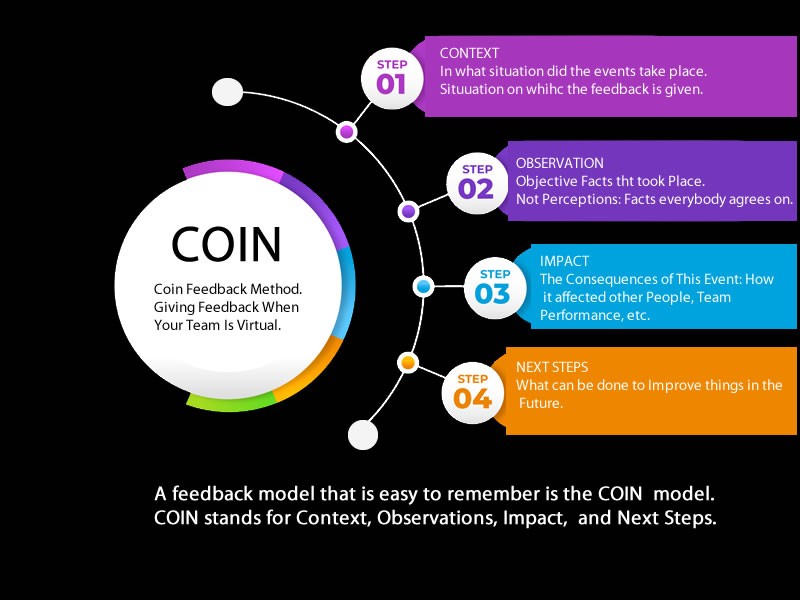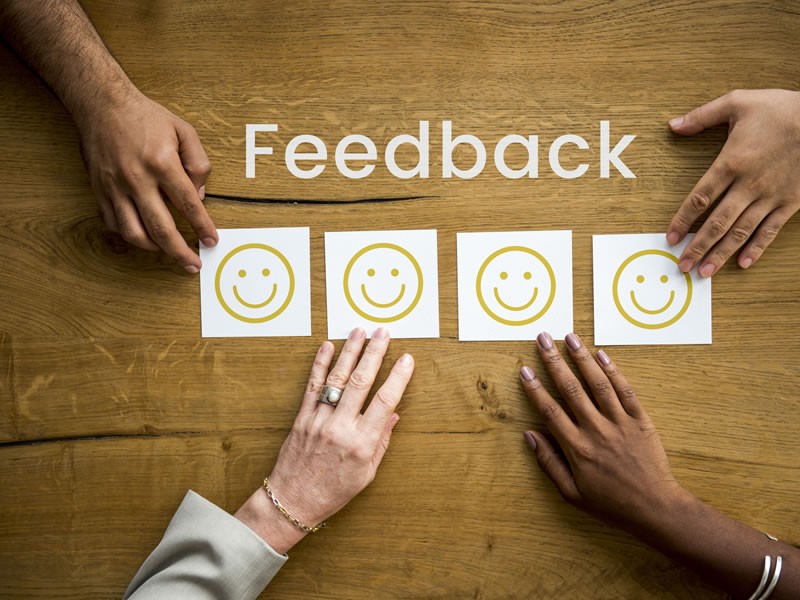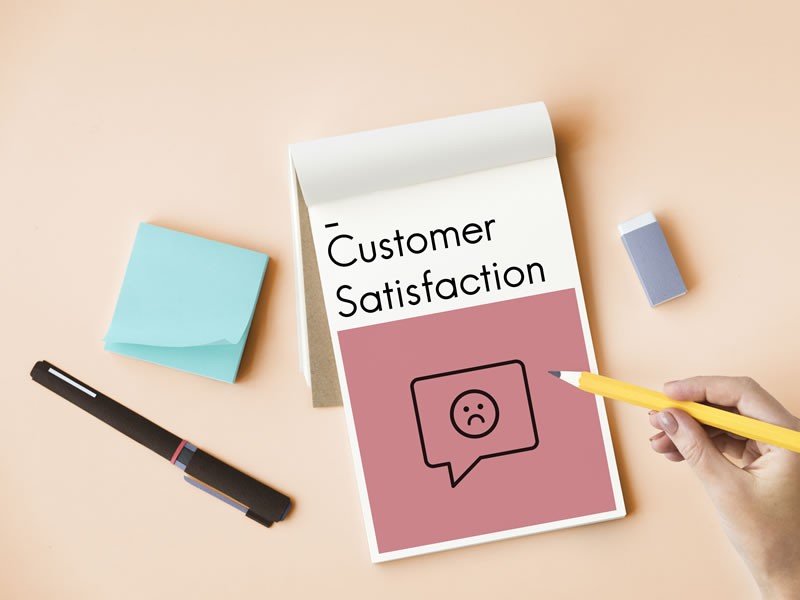Insight Blog
Agility’s perspectives on transforming the employee's experience throughout remote transformation using connected enterprise tools.
7 minutes reading time
(1407 words)
Featured
Coin Feedback Method | UPDATED 2024 | A Complete Guide
The COIN feedback model is a four stage method for delivering individual feedback.
Giving critical criticism to others without making them defensive or confused is one of the most difficult skills for leaders to master. The COIN feedback approach provides a framework for providing non-confrontational, conversational feedback. It also aids in the preservation of your relationships by establishing an understanding between you and the other person about the improvements that may be expected.
Setting the Context, addressing Observations and Impact, and concluding with a plan for what's "next" in terms of future behaviors and activities are all part of COIN.
What is COIN feedback?
It might be difficult to give feedback at times. It is possible that you need to have a different type of conversation with a team member about poor performance or undesirable conduct, but what begins as a casual conversation quickly escalates. Harsh words are spoken, accusations are thrown around, and the relationship might be gravely harmed. Alternatively, you may notice that the individual nods in agreement during the discussion, but their behavior or performance does not improve.
Ask yourself how your feedback can be aggressive, fair, and understandable at the same time? And, perhaps most significantly, how can you guarantee that the receiver is completely aware of the modifications or improvements you anticipate from them?
The COIN Model was created by executive coach and author Anna Carroll, MSSW. It's a straightforward framework for planning and structuring unpleasant talks and criticism in a non-confrontational manner.
Coin Feedback Method
COIN follows the same broad guidelines as other feedback exchanges. To begin, ensure that you have a quiet chat with your team member where you will not be disturbed.
Second, provide input from your perspective. "I comprehend that..." or "I know that..." are examples of "I" sentences. In this manner, you may highlight your point of view while avoiding making rash judgments or accusations. Instead of saying, "You've done this badly," you may say, "I'm unable to grasp what you've been doing." Here is how the COIN Conversation Model may be used to offer feedback.
You've seen some tension between Andy, a young team member, and Sarah, a senior project manager, on your team.
After that, you wait to see whether they can figure things out on their own at first. Andy, on the other hand, approaches you in private. He's irritated by Sarah's behavior and a specific issue with her. She has refused to accept a project handover from him since part of the documentation has not been done correctly. He also thinks her demeanor is becoming overly argumentative. So, you can use the COIN feedback model to handle this situation.
Coin Feedback Examples
Over the last several years, there has been a lot of change in the area of performance management. Organizations are updating their rating and reward procedures, and employees are seeking clarity in job goals and indicators of performance.
- -You can use the coin feedback method:
- -When people are expecting feedback
- -When people know how to use COIN feedback
- -Where performance reviews are conducted
- -Where you use lessons learned sessions
Coin Feedback Model
Giving feedback may be intimidating for many individuals. As a result, they created the COIN Model to assist you in providing practical feedback that will assist your peers, boss, or direct report in improving their performance and allowing them to grow.
To assist you in constructing useful feedback, follow the COIN framework's four basic stages. This strategy may be utilized to offer both motivating and developmental comments.
First step
Begin the feedback process by striking up a discussion with the person and establishing a connection with them over the issue you'll be giving feedback on. It's all about establishing the tone and getting people in the appropriate mindset to think about the circumstance and acts you're giving criticism on.
Second step
The COIN Feedback Model's second step is "observation." After you've built a link to the topic, you'll want to present the activities or behaviors for which you want to offer feedback. These should be particular observations that you have made. They should be factually accurate and free of emotional jargon.
Third step
After you've reported your findings, you'll need to demonstrate the effect of the acts or behaviors you noticed. This is the "so what" stage of the dialogue, and it's critical in assisting someone in comprehending why and how their actions or behaviors impacted others. This knowledge is necessary if they are to modify their ways in the future. "Next steps" is the final stage of The COIN Feedback Model.
You must now assist the individual in preparing to modify their activities or habits once you have proved their impact. They must consider and imagine how they should have acted, as well as what they need to do to avoid consequences.
Start Stop Continue Feedback
It is a user-friendly model that allows you to get input on three different aspects: things you need to start doing, things you need to stop doing, and what things you should keep doing.
This method not only encourages employees to review the company's or a teammate's performance but also allows them to explain why they did so. It also allows for ideas from participants.
Is there anything your employee should refrain from? This part of the feedback takes a step back and helps the manager to identify behaviors or activities that did not work or did not contribute to the employee's or company's success. Goals and tasks that have been canceled may also fall under this category. These are the most critical comments in the center, perfectly wedged. Managers should provide specific examples and explanations for why things didn't work and be prepared to address the situation with the employee.
After that, you need to ask what your employee needs to stop doing. This part of the feedback takes a step back and helps the manager to identify behaviors or activities that did not work or did not contribute to the employee's or company's success. Goals and tasks that have been canceled may also fall under this category. These are the most critical comments in the center, perfectly wedged. Managers should provide specific examples and explanations for why things didn't work and be prepared to address the situation with the employee.
What do your employees need to do in the future? You need to identify successful behaviors or acts that led to the employee's success or achievement of goals. To capitalize on their success, these aspects should be maintained and improved. This is a chance to congratulate yourself on a job well done and to reward good conduct.
Advantages of Start Stop Continue Feedback
The use of Start Stop Continue Feedback is an excellent habit to establish. And, like any good habit, it takes time and effort to develop. This is about the team becoming used to having difficult talks and getting together on a regular basis. It could be a little toe-curling the first time you do it. But if you stick with it, things will start to come out and get mended. After all, many of our habits are unconscious, and we won't change them unless we realize them.
Our recommendation is to start cautiously if you're starting from the point of zero trust. Don't march in and expect no-holds-barred, no-holds-barred input. Begin by having your team write down all of the beautiful things they think about each other on a post-it note — this is the 'Continue' phase of the activity. You're starting on a good note and promoting the simplest talks to get everyone acclimated to praising one other by presenting a round of praise first.
This model's outcomes might spark a conversation that leads to a team charter. The whole team recognizes and commits to the behaviors that they value. They also have an impact on whatever work you undertake on your Culture Canvas. Keep in mind that your company's Executive Team cannot outperform itself. Working through this self-introspection together, determining how you want to show up for each other and what you'll do differently, will guarantee that you don't undercut the influence you want to have.
Categories
Blog
(2600)
Business Management
(319)
Employee Engagement
(207)
Digital Transformation
(173)
Intranets
(119)
Growth
(118)
Remote Work
(61)
Sales
(48)
Collaboration
(37)
Culture
(29)
Project management
(29)
Customer Experience
(26)
Knowledge Management
(21)
Leadership
(20)
Comparisons
(5)
Ready to learn more? 👍
One platform to optimize, manage and track all of your teams. Your new digital workplace is a click away. 🚀
Free for 14 days, no credit card required.

















